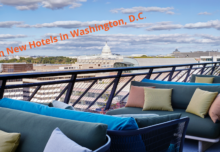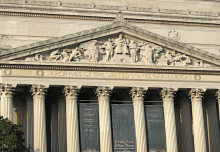Iconic DC Hotels
While Washington itself has great history, it has been through repeated cycles of depression and redevelopment, especially in what are now some of the most popular tourist areas. So, it has fewer hotels whose legends reach back to earlier eras than do capitals of Europe. In fact, the Watergate, arguably the most famous hotel in D.C., has been shuttered for several years as one developer after another has investigated returning it to star status.
There are a few notable iconic DC hotels, however, starting with the Willard Hotel, which faces Pennsylvania Avenue a block east of the White House. (Actually, the hotel’s roots go back to six 1816 town houses, but it underwent an extensive rehab after a 1922 fire that rousted then-Vice President Calvin Coolidge and several senators.) After two decades of neglect and a multimillion-dollar renovation by InterContinental, it’s back to its 1901 Beaux-Arts glory. Its history is impressive: Julia Ward Howe wrote the lyrics to “The Battle Hymn of the Republic” while staying there; the newly elected Lincoln lived there while awaiting inauguration; Dr. Martin Luther King Jr. wrote the “I Have a Dream” speech there as well. Its Round Robin Bar claims to be the spot where powerful Kentucky Senator Henry Clay introduced the bourbon (as opposed to brandy) mint julep. While the hotel also claims that the term “lobbyist” came from the fact that influence peddlers lurked in its lobby hoping to buttonhole its presidential and diplomatic patrons, that’s probably apocryphal. Nevertheless, the hotel’s list of former guests, from Charles Dickens to Harry Houdini to Gypsy Rose Lee and a positive passel of presidents, is too long to reproduce.
Although the building of the Hay-Adams Hotel does not truly incorporate the side-by-side mansions of Lincoln private secretary John Hay and author Henry Adams, the grandson and great-grandson of presidents, it was built on that White House–friendly site, and retains much of the look and elegance of that mid-19th-century era. (Clover Adams, who famously committed suicide here by drinking photographic cyanide solution, is said to haunt its halls.) Its view across Lafayette Park toward the Executive Mansion is breathtaking (very rarely, during the odd protest scuffle involving tear gas, that might be literally true). Its cocktail lounge, Off the Record, is a favorite among power drinkers and cocktail anecdote collectors alike.
The Mayflower, about four blocks from the White House, has long been nicknamed the “Grande Dame of Washington,” famous for the amount of gold and gilt, unsurpassed in the nation except by the Library of Congress (much of it visible in the block-long lobby promenade), and the fact that it has hosted a presidential inaugural ball every four years since Calvin Coolidge’s day. (It’s the city’s longest continually operating hotel, since 1925.) FDR rehearsed his “fear itself” speech here; Truman, who kept a room at the hotel after leaving 1600 Pennsylvania Avenue, called it “the second best address in Washington.” Its Town and Country Lounge hosted FBI director J. Edgar Hoover (chicken soup and cottage cheese) and his companion Clyde Tolson at lunch for two decades; the renovated room is now called the Edgar Bar and Kitchen in his, um, honor. It’s also a magnet for scandal lovers: Clinton “aide” Monica Lewinsky and Kennedy’s mob-related mistress Judith Exner both stayed there; it was also the site of then–New York Governor Eliot Spitzer’s partying with a very expensive escort in 2008, which cost him his job.
The much smaller Morrison Clark Inn began its life as two private homes, built in 1864, and served for many years as the Soldier’s, Sailor’s, Marine’s, and Airmen’s Club, a prominent First Ladies’ charity. It’s not a typical hotel—it barely has what passes for a lobby—but more like a romantic B&B with a restaurant, most alluring for those who love the original touches, such as the Shanghai tile roof, Carrara marble fireplaces, antique furniture, and more.
The Beaux-Arts Jefferson Hotel was completely renovated in 2009—uncovering a stunning lobby skylight in the process—and now salutes its namesake wine-loving president with Monticelloinspired architectural elements, such as a parquet floor and toile draperies, signed documents and artifacts, a hand-painted silk mural in the Plume restaurant of his own vineyard there, and a glass ceiling that could inspire the first woman president. But it also has technological innovations that inventor Jefferson would have loved: free international phone service, as well as Wi-Fi and daily newspaper downloads, plus 24-hour butler service.
For more iconic DC hotels and a complete list of all Washington DC hotels check out The Unofficial Guide to Washington D.C. by Eve Zibart.
Photo credits for Iconic Hotels DC:
The Willard courtesy Rdsmith4 (Own work) [CC-BY-SA-2.5], via Wikimedia Commons
The Mayflower Hotel courtesy Aaron Siirila [CC-BY-SA-2.5 ], from Wikimedia Commons







